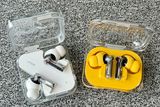Five wearable tech items we can expect to embrace in (and transform) our lifetimes
A Fitbit employee on a treadmill at last year’s IFA in the German capital
Wearable technology is not a new phenomenon, with the most well known product the FitBit having its first release in 2013, but the industry has not yet realised its full potential.
This underrated sector is on the brink of change, as its future is appears not only bright, but also [some may say] alarmingly close.
Top scientists are currently working on developing and enhancing technology in wearables, and the industry has now emerged as an area which is expected to continue to progress over the coming decades.
The comeback: are we ready?
It’s safe to say that the wearable technology movement has been arguably slow and at times considered unnecessary. Tech Dissected described the feedback to Google Glass, first released in 2012, as 'perhaps one of the most controversial technological steps forward, with as many haters as there are lovers of the super-slick glasses'. We might not have been ready for wearable technology five years ago, but with extensive research and development,this industry is due to make a big comeback.
Well-known wearable items such as the Fitbit and the Apple Watch may not have a life-changing effect, but the future of wearable technology has a lot more to give, particularly as regards its potential use in the health industry.
Google Glass
With 422 million adults with diabetes worldwide, the introduction of Nemaura Medical’’s SugarBEAT, a bluetooth diabetes skin patch that displays glucose readings at just the touch of an app, is sure to transform the way a large number of people live their lives.
The Zephyr Anywhere’s BioPatch, meanwhile, is a small piece of technology that can be attached to a patient’s chest and collect vital signs and medical data that can then be transmitted to doctors and nurses. This is a lot more sophisticated than a fitness tracker, and will allow hospitals to become more efficient and enable patients to be better looked after.
Furthermore, just this month, the US Food and Drug Administration revealed their approval of a 'ingestible' pill with a sensor, which is able to digitally track whether patients have taken their medication.
But it's not just health professionals and patients that are set to embrace these enhanced products. Wearables are paving the way to the future - and we're taking a closer look at some of the technologies we can expect to be wearing in our lifetimes.
Read more:
1) Smartglasses
Wearable tech is expected to be hitting us hard by 2022, with the revolution of glasses, as people with no prescription will be wanting a pair and those that need them will no longer see them as a hindrance or annoyance. By this date is it expected that 10pc of glasses and headsets will be 'intelligent' and able to connect to the internet. Want to look something up? We simply need to use our eyes.
However smart glasses will not just be used to browse the internet, but are also likely to be used in the workplace, particularly to aid guided training. By having a third pair of eyes that can monitor your work, this data will be incredibly useful to help fix potential errors and mistakes.
2) Solar energy
Moving forward still only a couple of years and we get to 2025, where we can expect to see clothes that create and harvest their own solar energy, begin to appear on the market. Solar cells will feature on clothes to power our connected devices such as mobile phones. Say goodbye to the difficulties that come with forgetting to pack a charger for a long day.
3) Transforming health
In the same year, wearable technology will be making a leap into the health sector, as clothes will be able to protect you from disease and ill health. Perhaps it’s time for the clothing and pharmaceutical industries to join forces as soon they’ll be in major competition; smart clothes will be boasting built-in monitors that can enhance fitness and improve health. We can’t argue with the benefits this industry is set to achieve across the globe.
4) Drones (wearable tech at a distance)
We all own our own waterproof clothing, but by 2030 we may not need them at all, as drones will be protecting us from the seasons; adverse effects. From solar rays, rain and air pollution, drones will be shielding us by hovering in front and around us as we go about our days.
5) New shoes?
A little bit further into the future, but still in many of our lifetimes we reach 2050, where we are expected to be boasting shoes that harvest kinetic energy. This basically means our shoes will be powering the wearable technology we wear. But these shoes intelligence don’t stop there, as they master one of the biggest pet peeves we currently face with clothing; undone shoelaces. In just over three decades, our shoes will be able to detect when it’s being placed on a foot and tie up its laces on its own.
Whilst these are some of the key changes the industry of wearables is set to make, there are endless projects currently being undertaken in this sector. From products that will help parents monitor their baby's health, to ways this technology will help smokers give up their habits, the possibilities are endless.
We’re beginning to see this underrated industry begin to break away from its Fitbit-only stereotype, as it’s set to change our lives as we know it.
Simon Duggleby, from the Marketing team at RS Components
Join the Irish Independent WhatsApp channel
Stay up to date with all the latest news














